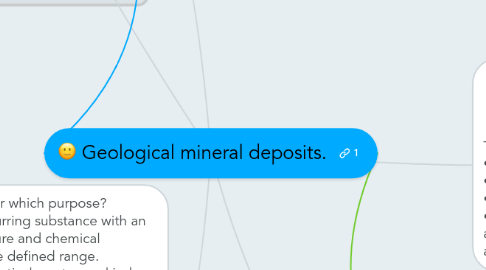Geological mineral deposits.
by daniel gomez contraras

1. The metal deposits: some metals deposits such as: Mineral Occurrence: is an abnormal concentration of a mineral that is considered valuable by someone somewhere or is of a scientific or technical interest. Mineral deposit: a mineral occurrence (abnormal concentration of a mineral or metallic element) size (volume) and sufficient in law to favorable circumstances, be considered with economic potential.There are many more who read
2. Nonmetallic deposits:Among the non-metallic or industrial deposits are mainly deposits of materials that are used every day in modern society as stone, carbonates (limestone, dolomite), salts, sulfides, magnesite, gypsum, talc, fluorspar, asbestos, cement , gravel and sand, marble, granite, clay (kaolin, bentonite, montmorillonite), etc. These materials are usually of low value, high volume, so its operation is always performed at or near the source of production. Only in special cases acquire great development since it depends on the needs of the geographic region, economically, do not support large transportation.
3. What are minerals? For which purpose? Mineral: naturally occurring substance with an orderly internal structure and chemical composition within the defined range. Minerals can be of practical use to mankind, either for its mineral properties or for extracting particular element (s) (s) such as metals (mineral ore). Mineral resources are divided into three major families, metallic, non-metallic and energy. Metal: ore minerals of which metals of interest are obtained. Non-metallic: minerals used directly in industrial processes, technology, construction, etc. Energy resources: petroleum, natural gas, coal, uranium, etc.
4. Deposits of fossil fuels:Fossil fuels are geological deposits of mineralized organic compounds (hydrocarbons), resulting from the decomposition of plants and animals for hundreds of millions of years subjected to heat and pressure from many layers of sediments in the Earth's crust and underwent chemical transformation and biological and ended up turning into oil, coal and natural gas.
5. The main ore minerals are: • Native gold and silver • electrum • acanthite and tetrahedrite • occur as quartz silica (most often forming aggregates comb), amethyst, opal, chalcedony and cristobalite


